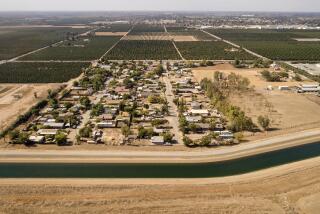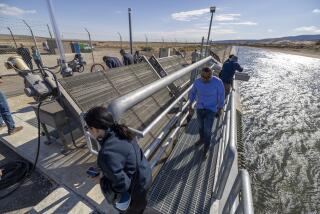Drought has 14 communities on the brink of waterlessness

- Share via
Reporting From MADERA COUNTY, CALIF. — Under the blistering Central Valley sun, Filiberta Sanchez and her toddler granddaughter strolled down a Parkwood sidewalk lined with yellow weeds, dying grass and trees more fit for kindling than shade.
“It was very pretty here, very pretty,” said Sanchez, 56, as little Jenny crunched a fistful of parched dirt and pine needles she grabbed from the ground. “Now everything’s dry.”
------------
FOR THE RECORD
An earlier version of this post said that the city of Montague lies in Shasta County. It is actually a part of Siskiyou County.
------------
Parkwood’s last well dried up in July. County officials, after much hand-wringing, made a deal with the city of Madera for a temporary water supply, but the arrangement prohibited Parkwood’s 3,000 residents from using so much as a drop of water on their trees, shrubs or lawns. The county had to find a permanent water fix.
Parkwood is one of 28 small California communities that have since January cycled onto and off of a list of “critical water systems” that state officials say could run dry within 60 days. Amid the drought that is scorching the state and particularly the Central Valley, the State Water Resources Control Board decided this year, for the first time ever, to track areas on the brink of waterlessness.
“It’s a sign of how severe this drought is,” said Bruce Burton, an assistant deputy director for the board.
For some communities, earning a place on the list was the impetus to address problems that should have been fixed long ago. Some drilled new wells, built storage tanks or connected their water systems with larger ones and got off the critical list. Other communities were saved by late spring rains that filled reservoirs and other water supplies.
Fourteen communities, though, remain on the list, approaching a crisis point and trucking in water while they work to find a solution.
Tim Quinn, the executive director of the Assn. of California Water Agencies, said communities that have made the list are often small and isolated, and they relied on a single source of water, such as a stream, without backup sources. But he warned that if the drought continues, larger communities could face their own significant problems.
“If this drought keeps on going, some larger, more sophisticated communities are going to be in trouble next year,” Quinn said.
Near the Oregon border in Siskiyou County, the city of Montague with a population of about 1,400 is one of the list’s success stories. It had long used an irrigation ditch that transported water from a lake 25 miles away. But the ditch ran dry and, in April, Montague landed on the critical list.
Working with state and federal agencies, Montague built a pipeline that pumped water from wells near Lake Shastina into the Shasta River and then into residents’ homes, said Chris Tyhurst, Montague’s water supervisor.
“The good thing about the project is that it solves long-term problems as well as this year’s,” he said. “If we hadn’t gotten our pipeline finished like we did, we’d probably have had about three or four more weeks of water left, and that would have been that.”
With the pipeline built, Montague was removed from the list this month.
Arroyo Seco Resort, tucked along a windy, mountainous road on the edge of the Los Padres National Forest in Monterey County, has been on the critical list since late August.
For the last three weeks, the resort has paid $350 each for about five truckloads of water, said Glenn Dugger, 65, the resort’s supervisor. (The resort is asking the state for a reimbursement.)
With 62 cabins, the century-old resort has a peak population of about 130 full-time and part-time residents who relied on the Arroyo Seco River for water.
On a recent afternoon, Dugger stood in the bone-dry river bed. It dried up a few months ago, and the one 27-foot-deep well that still works can’t pump enough water for the resort. Arroyo Seco means “dry creek” in Spanish, Dugger said, and “It’s living up to its name.”
The resort has asked for state help to dig wells as deep as 200 feet. Meanwhile, residents are asked not to water outdoors, leaving the once lush resort faded and brown.
Other communities that remain on the list include Lake Berryessa Resort in Napa, Woodside RV Park in Mendocino County and Lupin Lodge, a nudist resort in the Bay Area that is facing accusations of water theft.
Burton, at the water board, said the state started tracking at-risk water systems in January. State officials were already working with many of the communities, funding projects — along with the U.S. Department of Agriculture — to shore up water supplies by digging new wells, making existing ones deeper or hauling in outside water. The state is also using emergency drought funds for water projects that officials hope will keep some areas from earning a spot on the critical list.
“We didn’t want water systems to come to us and say, ‘Oh, we ran out of water today,’” Burton said.
Parkwood saw signs of trouble even before its well dried up. Water pressure in some showers slowed to a dribble and toilets barely flushed.
Johannes Hoevertsz, Madera County’s public works director, said that without the city of Madera’s help Parkwood would almost certainly have run dry. After the remaining well failed, the county passed out bottled water to residents and warned people to boil water before drinking or cooking with it.
Driving his county pickup through Madera — just across from Parkwood — Hoevertsz spotted a sprinkler dousing a green yard, a luxury that could net a Parkwood resident a $75 fine. A few Parkwood neighbors take the risk, though, their green lawns probably kept verdant with surreptitious watering in the dark, early morning hours. Most, though, were brittle and brown.
Phil Magos, 67, a Parkwood resident for 23 years, said watching his yard die was painful. Among the casualties was a beloved fern he and his wife, Debbie Magos, brought with them to Parkwood as newlyweds.
“I feel bad when I go outside because it looks horrible,” he said. “When people drive in our neighborhood and they look around, they probably think, ‘Wow, this is a really bad area to even consider buying a house.’”
With the neighborhood wilting, Hoevertsz in early September pleaded with Madera to allow Parkwood residents minimal watering privileges. On Wednesday, the City Council unanimously voted to allow watering of shrubs and trees. Hoevertsz said he’s confident the faltering well will be repaired soon, so the neighborhood can end its reliance on charity.
Despite the pall the drought has cast over Parkwood, Hoevertsz said it may have been a necessary prod for change.
“If it starts raining tomorrow,” he said, “let me tell you, nothing’s going to be done about the drought.”
hector.becerra@latimes.com
Twitter: @hbecerralatimes
More to Read
Sign up for Essential California
The most important California stories and recommendations in your inbox every morning.
You may occasionally receive promotional content from the Los Angeles Times.














